Abstract
Intranasal inoculation of CD-1 or BALB/c mice with low doses of influenza A/PR8/34 (HON1) virus followed 48 h later by intranasal inoculation of low doses of type Ia group B streptococci effected a lethal synergism. At a constant input dose of virus, a direct relationship between input dose of bacteria and percent mortality was observed; the converse was also true. An inverse relationship between input dose of group B streptococci, but not input dose of virus, and mean time to death was observed in CD-1 but not in BALB/c mice. The kinetics of influenza A/PR8/34 virus and group B streptococcal replication in singly and dually infected BALB/c mice was determined by assaying samples from the lungs, liver, spleen, and blood for viable group B streptococci and infectious influenza A/PR8/34 virus. No significant difference in virus replication in the lung was observed between singly and dually infected mice. Extrapulmonary dissemination of virus was not observed. Concurrent virus infection effected a 10,000- to 100,000-fold increase in the levels of type Ia group B streptococci in the lung. Potentiation of group B streptococcal infection of the lung was not associated with bacteremia or infection of the liver or spleen, a finding contrary to previous observations of fulminant septicemia after intranasal inoculation of mice with input doses of group B streptococci less than one-tenth of the pulmonary levels observed in the present study.
Full text
PDF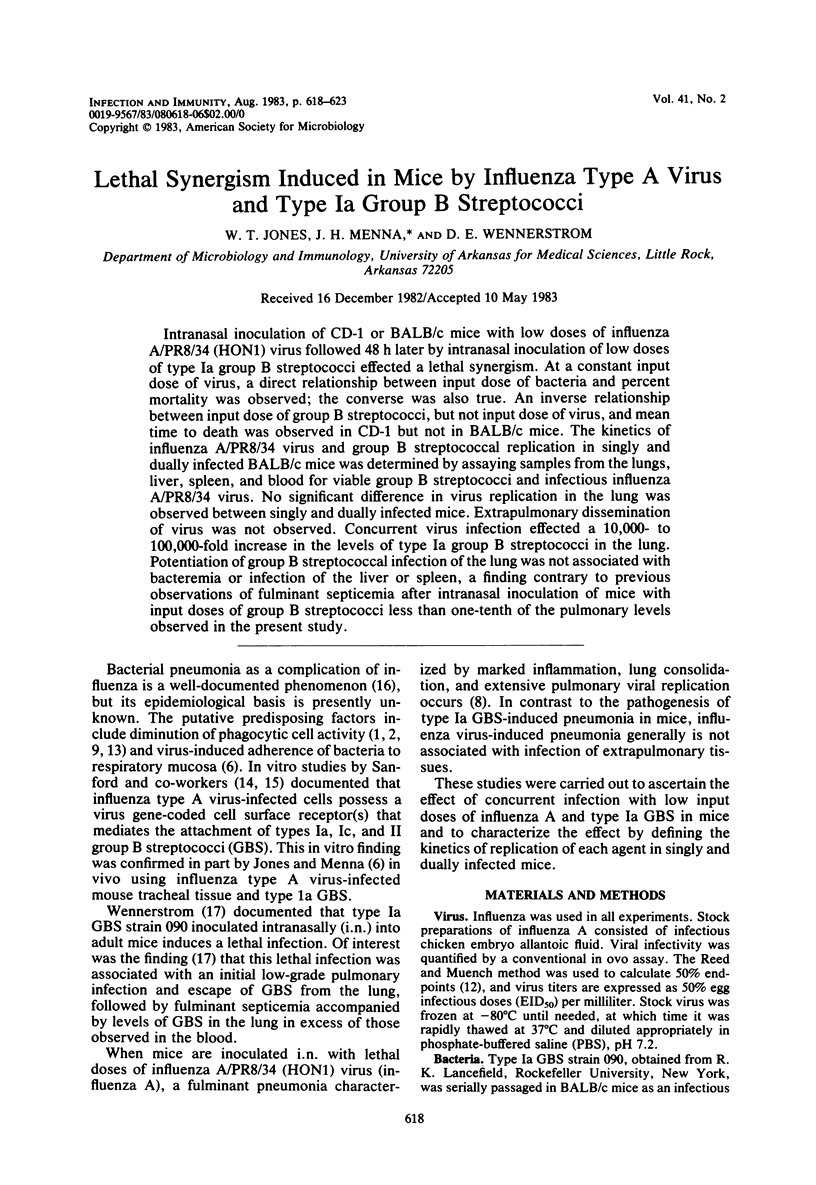
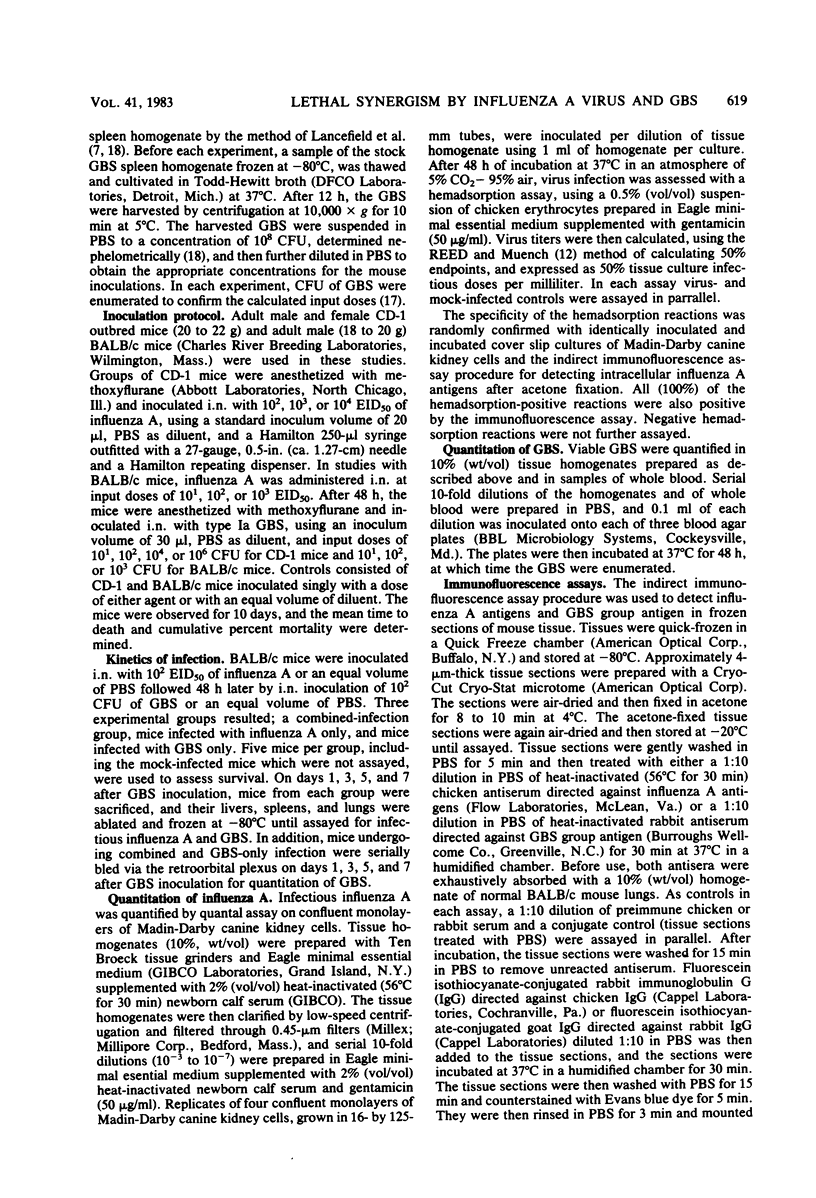
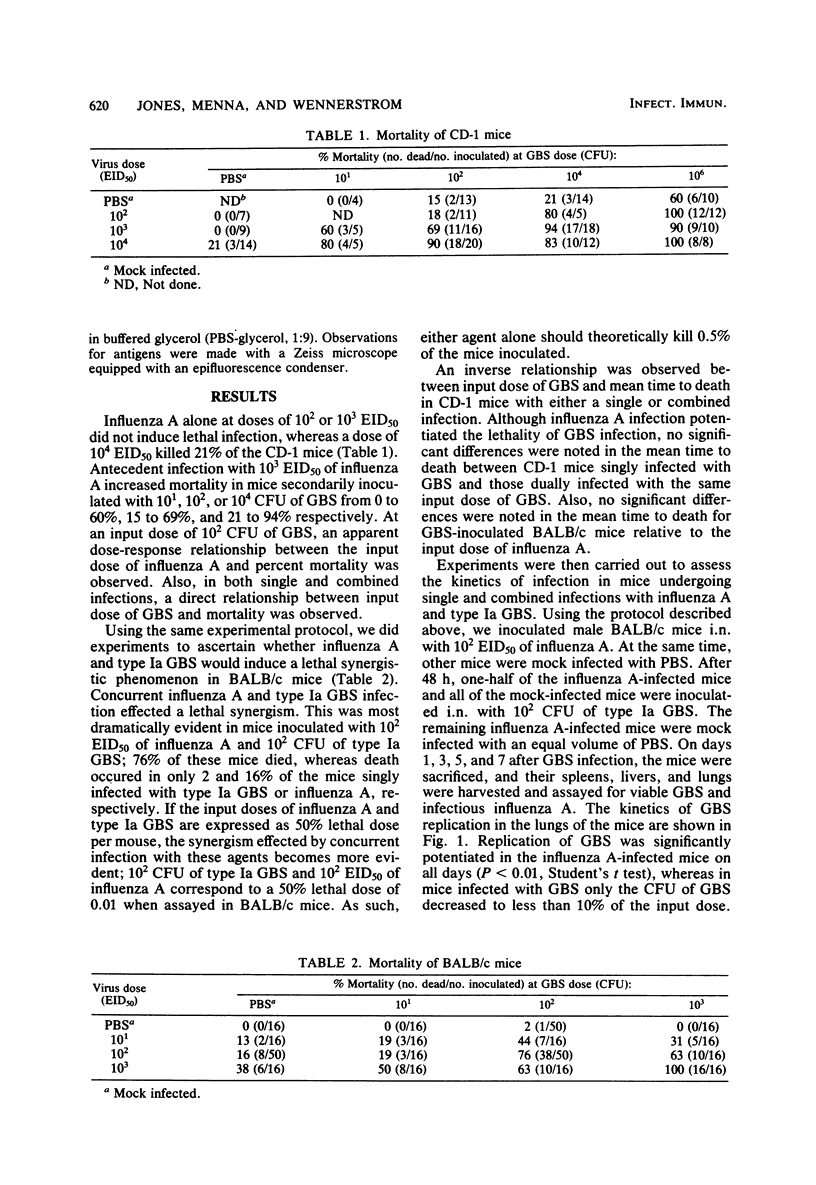
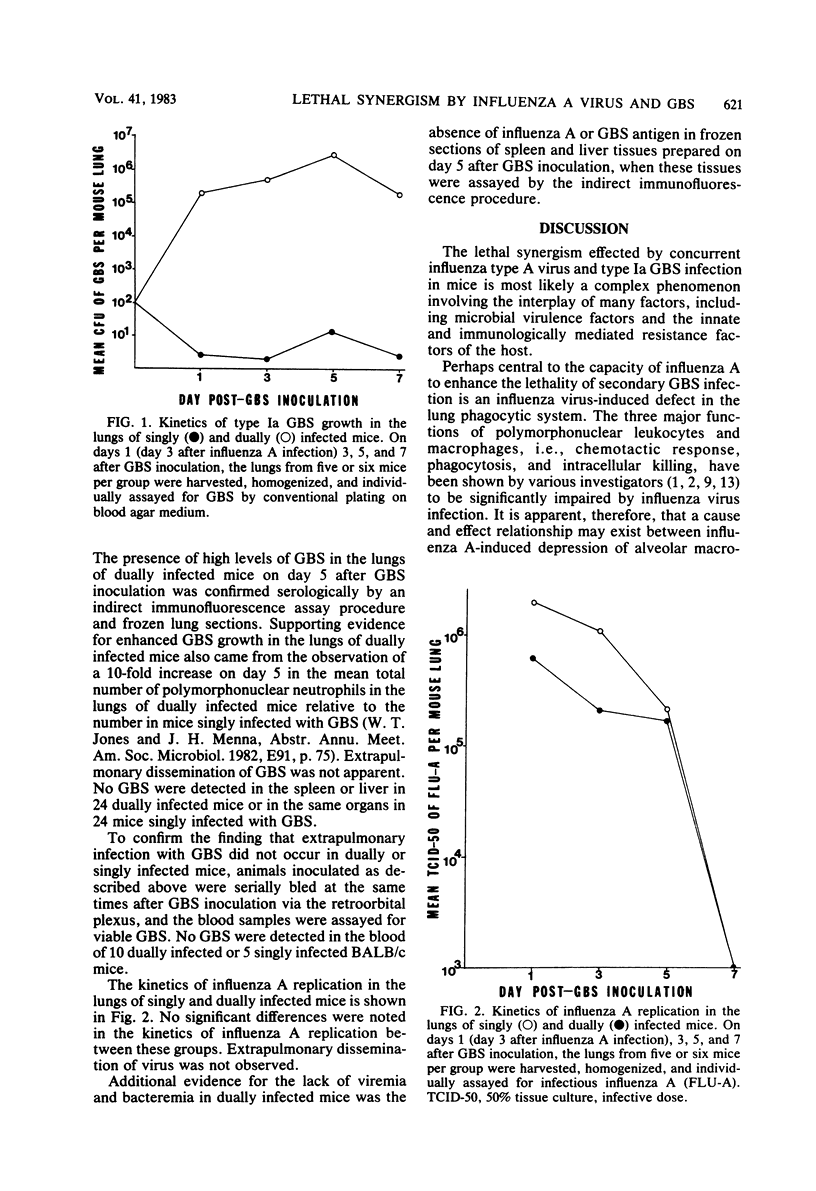
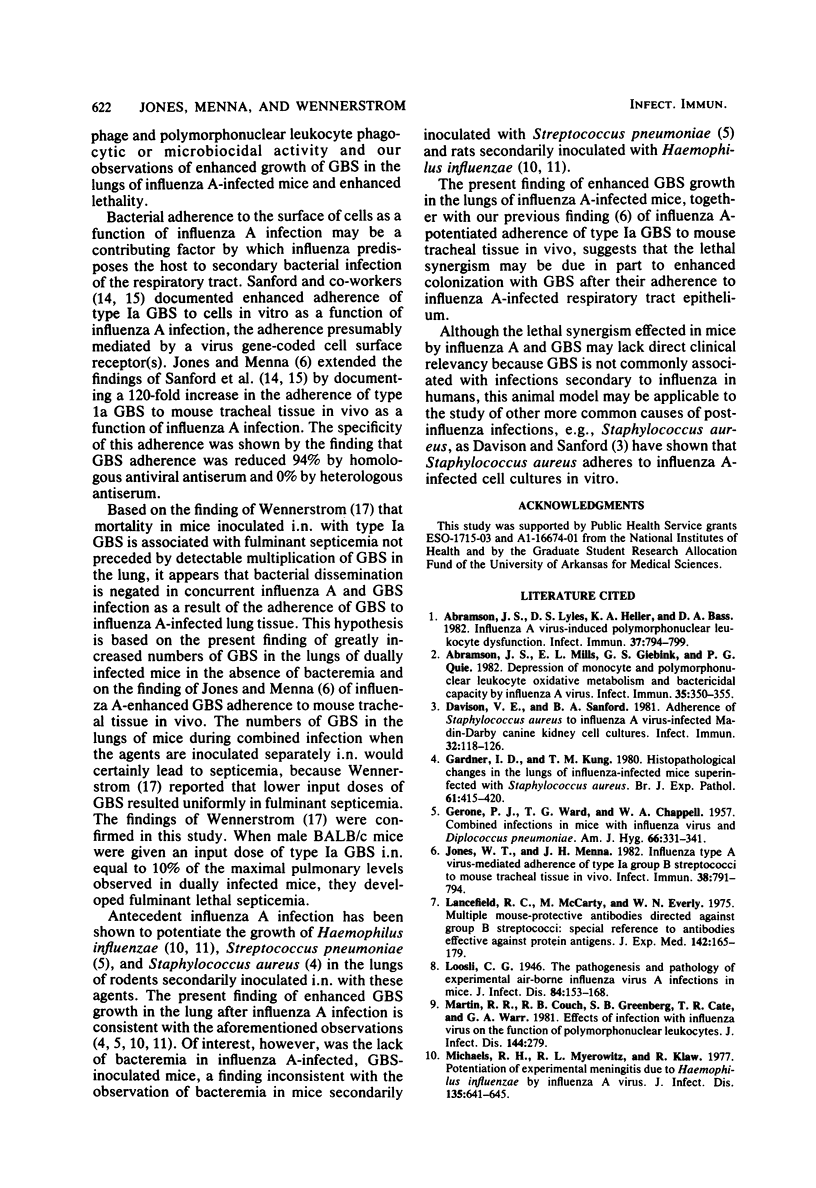

Selected References
These references are in PubMed. This may not be the complete list of references from this article.
- Abramson J. S., Lyles D. S., Heller K. A., Bass D. A. Influenza A virus-induced polymorphonuclear leukocyte dysfunction. Infect Immun. 1982 Aug;37(2):794–799. doi: 10.1128/iai.37.2.794-799.1982. [DOI] [PMC free article] [PubMed] [Google Scholar]
- Abramson J. S., Mills E. L., Giebink G. S., Quie P. G. Depression of monocyte and polymorphonuclear leukocyte oxidative metabolism and bactericidal capacity by influenza A virus. Infect Immun. 1982 Jan;35(1):350–355. doi: 10.1128/iai.35.1.350-355.1982. [DOI] [PMC free article] [PubMed] [Google Scholar]
- Davison V. E., Sanford B. A. Adherence of staphylococcus aureus to influenza A virus-infected Madin-Darby canine kidney cell cultures. Infect Immun. 1981 Apr;32(1):118–126. doi: 10.1128/iai.32.1.118-126.1981. [DOI] [PMC free article] [PubMed] [Google Scholar]
- GERONE P. J., WARD T. G., CHAPPELL W. A. Combined infections in mice with influenza virus and Diplococcus pneumoniae. Am J Hyg. 1957 Nov;66(3):331–341. doi: 10.1093/oxfordjournals.aje.a119906. [DOI] [PubMed] [Google Scholar]
- Gardner I. D., Kung T. M. Histopathological changes in the lungs of influenza-infected mice superinfected with Staphylococcus aureus. Br J Exp Pathol. 1980 Aug;61(4):415–420. [PMC free article] [PubMed] [Google Scholar]
- Jones W. T., Menna J. H. Influenza type A virus-mediated adherence of type 1a group B streptococci to mouse tracheal tissue in vivo. Infect Immun. 1982 Nov;38(2):791–794. doi: 10.1128/iai.38.2.791-794.1982. [DOI] [PMC free article] [PubMed] [Google Scholar]
- Lancefield R. C., McCarty M., Everly W. N. Multiple mouse-protective antibodies directed against group B streptococci. Special reference to antibodies effective against protein antigens. J Exp Med. 1975 Jul 1;142(1):165–179. doi: 10.1084/jem.142.1.165. [DOI] [PMC free article] [PubMed] [Google Scholar]
- Martin R. R., Couch R. B., Greenberg S. B., Cate T. R., Warr G. A. Effects of infection with influenza virus on the function of polymorphonuclear leukocytes. J Infect Dis. 1981 Sep;144(3):279–280. doi: 10.1093/infdis/144.3.279. [DOI] [PubMed] [Google Scholar]
- Michaels R. H., Myerowitz R. L., Klaw R. Potentiation of experimental meningitis due to Haemophilus influenzae by influenza A virus. J Infect Dis. 1977 Apr;135(4):641–645. doi: 10.1093/infdis/135.4.641. [DOI] [PubMed] [Google Scholar]
- Myerowitz R. L., Michaels R. H. Mechanism of potentiation of experimental Haemophilus influenzae type B disease in infant rats by influenza A virus. Lab Invest. 1981 May;44(5):434–441. [PubMed] [Google Scholar]
- Rodgers B., Mims C. A. Interaction of influenza virus with mouse macrophages. Infect Immun. 1981 Feb;31(2):751–757. doi: 10.1128/iai.31.2.751-757.1981. [DOI] [PMC free article] [PubMed] [Google Scholar]
- Sanford B. A., Shelokov A., Ramsay M. A. Bacterial adherence to virus-infected cells: a cell culture model of bacterial superinfection. J Infect Dis. 1978 Feb;137(2):176–181. doi: 10.1093/infdis/137.2.176. [DOI] [PubMed] [Google Scholar]
- Sanford B. A., Smith N., Shelokov A., Ramsay M. A. Adherence of group B streptococci and human erythrocytes to influenza A virus-infected MDCK cells. Proc Soc Exp Biol Med. 1979 Feb;160(2):226–232. doi: 10.3181/00379727-160-40424. [DOI] [PubMed] [Google Scholar]
- Sweet C., Smith H. Pathogenicity of influenza virus. Microbiol Rev. 1980 Jun;44(2):303–330. doi: 10.1128/mr.44.2.303-330.1980. [DOI] [PMC free article] [PubMed] [Google Scholar]
- Wennerstrom D. E. Group B streptococcal type Ia sepsis in mice after intranasal inoculation and the effect of infection on lungs. Infect Immun. 1979 Oct;26(1):287–293. doi: 10.1128/iai.26.1.287-293.1979. [DOI] [PMC free article] [PubMed] [Google Scholar]
- Wennerstrom D. E., Schutt R. W. Adult mice as a model for early onset group B streptococcal disease. Infect Immun. 1978 Feb;19(2):741–744. doi: 10.1128/iai.19.2.741-744.1978. [DOI] [PMC free article] [PubMed] [Google Scholar]


